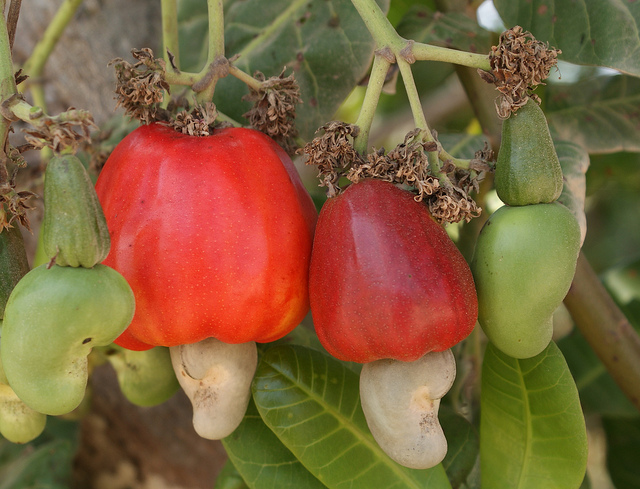
Crop: Cashew
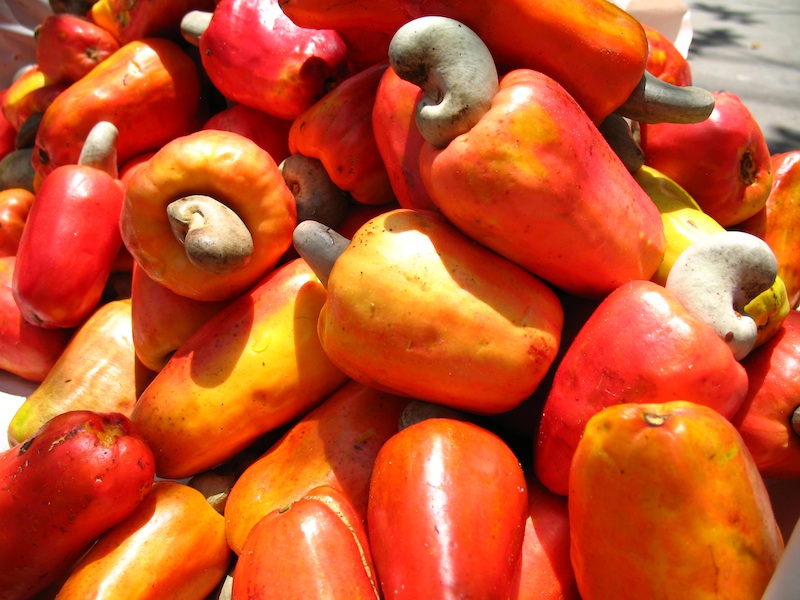
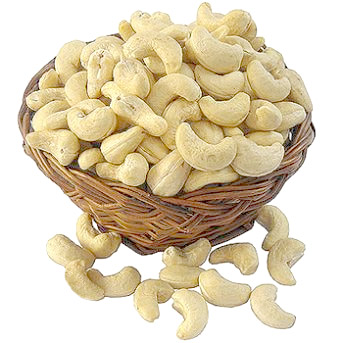
Cashew is one of the most important plantation crops in India as it brings in considerable foreign exchange earnings. In the state of Goa, it occupies the largest area among horticultural crops. This crop covers about 55 302 ha area with an annual production estimated at 27 070 tonnes.
Soil and climate: Well-drained deep sandy loam soils are the best for growing cashew. Heavy clay soils are not suitable, as cashew does not withstand water logging. In general, all soils from sandy to laterite are well suited for this crop. The light soils need to be replenished with adequate nutrients for better performance of this crop.
Cashew is an introduction from Brazil and is very well adapted to Indian coastal area under hot humid conditions with temperature in the range of 20 to38 o C, relative humidity in the range of 60 to95 % and annual precipitation in the range of 2000 to 3500mm. Extreme low temperature and frost are not conducive to raise cashew plantations. Edafic and agro-climatic conditions of Goa offer good scope for cultivation of cashew. Of late, the cultivation of this crop is being extended to non-traditional areas in the plains of Karnataka, Madhya Pradesh, Chattisgarh and some parts of North East hill region.
For planting new orchards, the land has to cleared off thorny bushes, shrubs and other weeds well before the pre-monsoon showers( April –May). Lay out the field with appropriate peg marking to facilitate digging of pits. Dig pits in the following way and leave them open for about 15 days for curing.
a) Normal planting in Square system: Pits of 60 cm X 60 cm X 60 cm size at a spacing of 7m X 7 m. (204 grafts / ha).
b) High density Planting in square system: Pit of 60 cm X 60 cm X 60 cm size at a spacing of 5m X 5m ( 400 grafts / ha)
a) Goa-1 (Balli-2), Vengurla-4, Vengurla-7, etc.
b) Grafts of promising local trees with bold nut, high yielding and bigger apple size can also be used in the respective areas for planting.
c) In order to minimize the loss due to pests and diseases, it is recommended to plant the grafts of more than one improved varieties.
Use soft wood grafts of improved and high yielding varieties After pre-curing, fill pits completely with top soil mixed thoroughly with one basket (15 ?20 kg ) of compost or Farm Yard Manure, 400 ?00 g rock phosphate and 100 g of Lindane to overcome termite problem.
Time of planting: The most ideal time for planting of cashew grafts is the period between June to July. Immediately after the onset of monsoon, plant the graft in the center of each pit and support it with appropriate staking. Complete planting before the end of June to take full advantage of monsoon. Take care that graft union is 10 ?5 cm above the ground level. Planting during this period ensures better establishment of grafts in the field. Ensure regular removal of side shoots arising below the graft joint.
Soft wood grafting:
Cashew is commercially propagated by soft wood Grafting. It involves four steps- i. Raising of root stock, ii. Selection of scion, iii Grafting and iv. After care of graft.
a) Raising of root stock: Collect fresh healthy seed nuts in the season, dry for 2-3 days and immerse them in water to remove the floating ones. Leave the seed nuts for soaking over night. Dip the sunken seed nuts in solution containing 40 g each of BHC 40% and Fytolan in 10 litres of water, for 5 minutes. Incorporate FYM (@3.0 tonnes/1000 m2) in to the soil thoroughly for preparing beds for sowing the stones. Prepare raised bed of 15 cm height and 1m width of convenient length. Sow the treated stones in a single layer and cove them with thin layer of soil and FYM mixed in 1:1 ratio. Irrigate the bed regularly. Stones germinate in 15 ?30 days. The seed-sprouts with good girth of epicotyl region and have just developed tender leaves are used as root stock for stone grafting (epicotyl grafting). After crossing this stage, subsequently, the seedlings can be used for soft wood grafting.
b) Selection and preparation of scion: Select the tree of scion variety of choice for propagation. Collect healthy, 3-4 months?old, matured shoots of 15 ?20 cm length which have dormant terminal or side buds on them. Each shoot forms a scion stick and can be used for grafting. Give two downward slant cuts (4 ?6 cm long) on opposite sides at the lower end of the scion stick to make it wedge shaped.
c) Grafting: For epicotyl grafting, uproot the seedling along with stone, from the bed before the leaves expand and decapitate it at the height of 8-10 cm. Make a cleft of 4 ?6 cm deep in the middle of the decapitated stem by giving a downward longitudinal cut. Now insert the wedge of the scion in to the cleft of the root stock in such way that the cambium of the scion and root stock come in perfect contact with each other. Tie the graft joint firmly with 1.5 cm wide and 30 cm long polythene strip of 100 gauge thickness. Plant the tied grafts in to polythene bag of 30cm X 20 cm size of 300 gauge with drainage holes and filled with potting mixture of soil, sand and cow dung in 2:1:1 proportion. Water the bagged grafts thoroughly. Planting in bag has to be done in such way that graft joint remains above the soil level in the polythene bag.
Similarly, for soft wood grafting also, make the cleft in the soft wood region of the seedling by retaining 2-4 fully expanded leaves just below the cleft region on the stem, insert the wedged scion in to the cleft and tied firmly in the joint region as described above. In this type, before grafting itself, the seedlings are transferred in to the polythene bags (30cm X 20 cm size of 300 gauge with drainage holes) containing the potting mixture (2:1:1) to encourage the pencil thickness of stem girth and 4-6 expanded leaves. Such grown up seedlings are used for soft wood grafting.
d) Aftercare: Keep the grafted plants under hot humid conditions under shade for about 15 ?20 days, till the sprouting of the buds on the scion. Regularly water the grafts depending on the weather conditions. Periodically, remove the side shoots growing on the rootstock below the graft joint. Remove the polythene strip used for tying the graft joint, after three months to avoid girdling of the stem. Protect the grafts from leaf eating insects and shoot borers by spraying the grafts with Nuvacron 2ml / l of water, in the nursery. After six months shift the grafts to other place or just lift the grafts and keep them in the place once in a month to prevent them from striking roots in to the ground below.
In situ grafting :
In order to reduce field mortality, get better growth and uniform establishment of orchard for early economic yield, in situ grafting is followed.
Fresh nuts of current season are sown in the pits filled with top soil and FYM to raise the root stocks in the main field itself. The vigorous seedlings when attain a growth of 12-15 months with 14-16 green leaves, subsequently, in the month of August or September, are veneer grafted with scion sticks of the desired variety. Favorable weather conditions during this period in Goa ensure higher rate of in situ graft success. The capping with poly bags can be done over the scion to get good success. Such grafts grow very fast and attain maturity in a few years due to undisturbed tap root system unlike in nursery-raised grafts.
Topworking :
Poorly yielding Trees of cashew trees can be converted in to desired commercial varieties by this method. The trees to be converted are either side grafted ore coppice grafted on new flesh with scions of desired variety.
Cashew responds well to fertilizer application. The fertilizer schedule for different age groups is as given below.
Age |
Nutrients (g /tree/year) |
Fertilizers (g /tree/year) |
|||||
|
Compost / FYM (kg) |
N |
P2O5 |
K2O |
Urea |
Rock phosphate |
Muriate of potash |
1 |
25 |
250 |
50 |
50 |
550 |
175 |
85 |
2 |
50 |
500 |
100 |
100 |
1100 |
350 |
165 |
3 |
50 |
750 |
200 |
200 |
1600 |
750 |
330 |
4th yr & onwards |
50 kg |
1000 |
300 |
400 |
2200 |
1500 |
660 |
Note:
1) Half of the dose can be applied in first week of June and remaining half in first week of August. For plantations on hilly terrains, to avoid leaching, entire dose can be applied once in first week of August. Problematic soils ( reclaimed mine rejects) need to be tested for soil properties for deciding the nutrient application. In case of high density plantations, fertilizer application can be adopted on area basis instead of per tree basis.
2) Organic cashew : Supplementing nutrients through organic sources like oil cakes, vermicompost, fish meal, bone meal, FYM and Poultry / pig manure, spray of EMO, etc may be adopted.
Open a ring of 15 cm depth and 1.5 ?2.0 m away from trunk. Apply fertilizer / manures in the ring, mulch it with green leaves and cover it with soil.
Allow the trunk to grow up to a height of 1 m by removing side branches. Prune the dried, diseased and chris-crossing lower branches every year.
Intercropping : During first 4 years, suitable inter crops can be had in the inter-space in cashew plantations of regular spacing under mild undulations or plain fields.. Ground nut, cucurbits, bhendi (okra), turmeric, ginger, chillies can be cultivated with appropriate crop rotations to get income during the juvenile period of plantation. Papaya and pineapple may also be planted as intercrop in the initial years under irrigated conditions. Drumstick which can serve as trap crop against TMB, with proper pruning can also be taken up along the contours
Allow the trunk to grow up to a height of 1 m by removing side branches. Prune the dried, diseased and chris-crossing lower branches every year.
Stem and root borer: Plocaederus ferrugineus
Symptoms of damage
Stem borer infection could be easily identified by the presence of small bore holes at the collar region. Extrusion of frass (like coarse dust powder) through the holes at the collar region.
Oozing of gum at the base of cashew tree trunk.
Finally yellowing and drying of trees.
Identification of insect pest
The eggs are whitish, ovoid in shape measuring about 3 mm in length (looks like rice grain).
The grown up grubs are off-white in colour measuring about 7-10 cm in length.
The adult is a medium sized, reddish-brown long horned beetle.
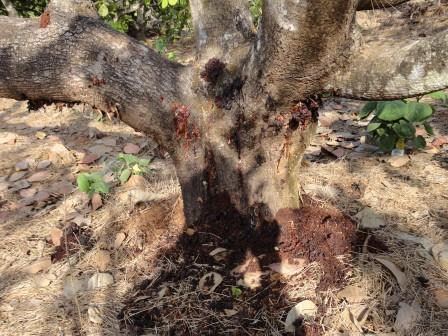
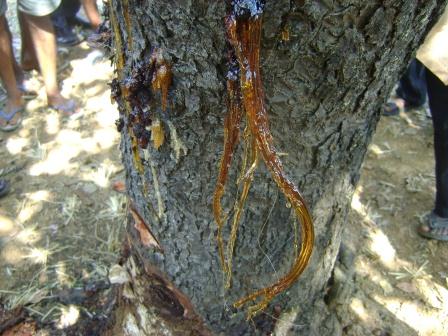
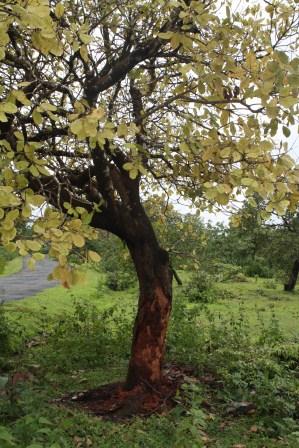
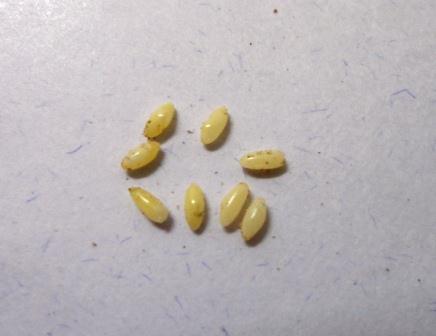
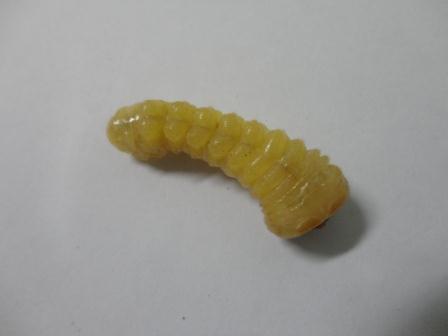
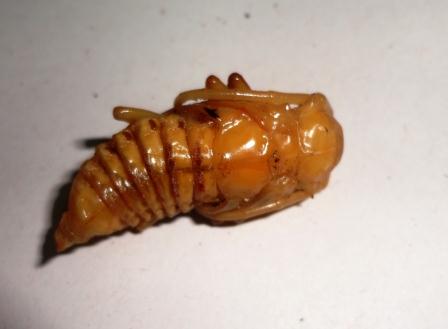

Management
Mechanical removal of the immature stages (grubs) of the pest during initial stages of infestation.
Removal of dead trees and trees with advanced stages of infestation at least once in 6 months.
Avoid injuring the plants by sickle and other garden tools, which otherwise will attract the adult for egg laying.
Treat the infested trees of the trunk region up to one meter height from the ground level and on exposed roots with Chlorpyriphos @ 10 ml in one litre of water.
Padding the stem with cotton-wool soaked with Monocrotophos 36 WSC @ 30 ml and closing the flap.
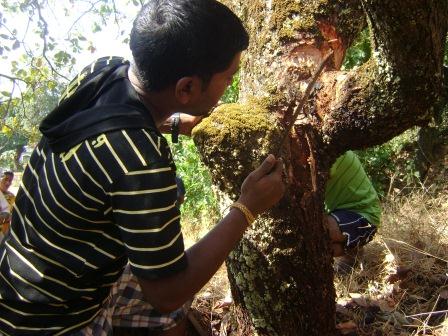
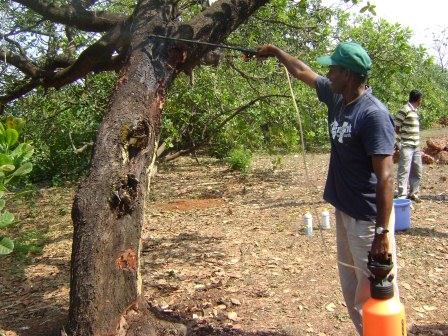
Tea mosquito bug: Helopeltis spp
Symptoms of damage
Both nymphs and adults of this mirid bug suck sap from the tender flushes, young shoots, inflorescence, panicles, growing young nuts and apples.
Occurrence of dark brown patches on green tender stem of young shoots and inflorescence rachis.
Feeding on tender leaves causes crinkling and curling. Affected shoots show long black lesions.
Heavily infested trees show scorched appearance, leading to the death of shoots and growing tips.
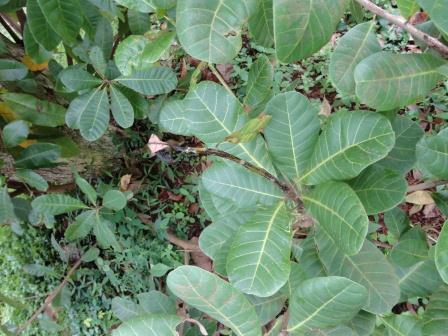
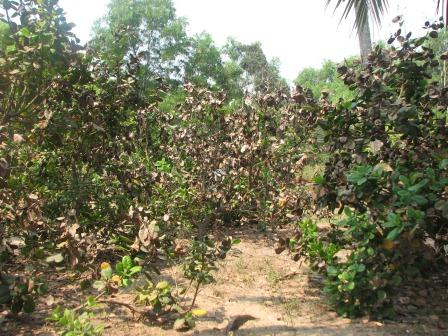
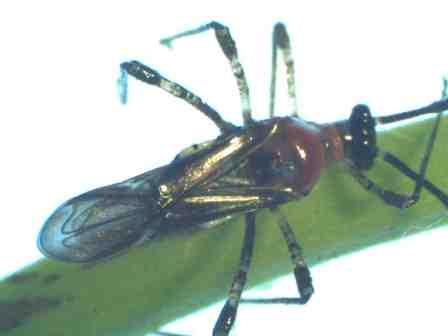
Identification of insect pest
The adult bug is reddish-brown, about 6-8 mm long with a black head, red thorax, black and white abdomen.
Management
Remove the volunteer (self-sown) neem plants and other weeds in and around cashew plantations.
Three spray schedules should be followed
1st Spray: Monocrotophos 1.5 ml/ litre of water (0.05%) or Lamda cyhalothrin at 0.003% during new flushing stage (November- December).
2nd Spray: Carbaryl 50% WP at 2g/ litre of water (0.1%) or Chlorpyriphos (0.05%) at flowering stage (Dec- January).
3rd Spray: Repeat the first spray at the initial fruiting stage (Feb-March)
Red ants Oecophylla smaragdina should be encouraged in cashew plantations as it will repel the tea mosquito bug.
Thrips: Flower thrips- Rhynchothrips raoensis (Thripidae:Thysanoptera) Foliage thrips- Selenothrips rubrocinctus
Symptoms of damage
Adults and nymphs are seen in colonies on the lower surface of leaves and suck the sap from leaves, inflorescence and apples and nuts.
Leaves become pale brown, scab on floral branches, apples and nuts, forms corky layers on the affected parts.
In severe cases there will be shedding of leaves and stunting of growth of trees.
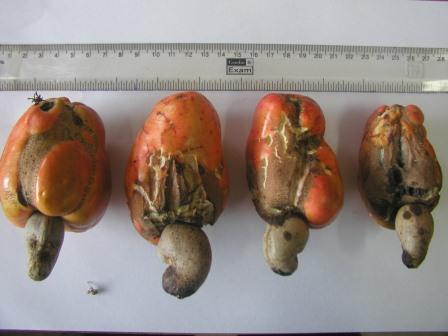
Management
Spraying of Monocrotophos 36 WSC 0.05% (@ 1.5 ml / lit).
Mealy bug: Ferrisia virgata
Symptoms of damage
The nymphs and adults of mealy bugs suck large amount of sap from the tender plant parts results in withering of growing shoots, inflorescence and developing fruits.
It can be seen on the lower surfaces of tender leaves, twigs, inflorescence panicles and fruit peduncles.

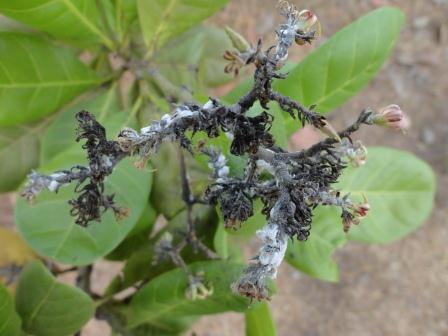
Management
Spraying of Monocrotophos 36 WSC 0.05% (@ 1.5 ml / lit).
Spray of dichlorvas 76 WSC 0.2% (@ 2.5ml / lit) or methyl parathion 50 EC 0.05% (@ 1ml / lit)
Leaf and blossom webber: Lamida moncusalis
Symptoms of damage
Presence of web on the terminal portions of new shoots and blossom is the initial symptoms of infestation.
The caterpillars are remaining inside web and feed on them.

Management
Spraying of Monocrotophos 36 WSC 0.05% (@ 1.5 ml / lit).
Spray of dichlorvas 76 WSC 0.2% (@ 2.5ml / lit) or methyl parathion 50 EC 0.05% (@ 1ml / lit)
It is advisable to take crop from fourth year onwards, before which flowers, if any, may be removed to encourage proper vegetative growth. The harvesting commences from February and continues till May. About 10 ?15 kg per tree (2- 3 tonnes/ha) of raw nut yield may be expected from 10th year onwards, and about 70 ?100 kg per tree (15 ?0 tonnes/ ha.) of cashew apple yield can be expected.
Storage : Nuts separated from apples are to be washed and dried for 3 days under sun, stored in gunny bags for further processing. Well dried nuts can be stored for longer period.
Age of tree |
Nut yield (Kg /tree) |
Apple yield (Kg/tree) |
Yield per ha* (tonnes) |
|
|
nut |
apple |
||
4th year |
0.5 |
3.5 |
0.1 |
0.700 |
5th ,, |
1.0 |
7.5 |
0.2 |
1.400 |
6th ,, |
2.5 |
17.5 |
0.5 |
3.500 |
7th ,, |
5.0 |
35.0 |
1.0 |
7.000 |
8th ,, |
7.5 |
60.0 |
1.5 |
10.0 |
9th ,, |
10.0 |
70.0 |
2.0 |
15.0 |
10th ,, |
12 - 15 |
85.0 ?100.0 |
2.5-3.0 |
15.0 ?0.0 |
*200 grafts/ ha ( 7m X 7m spacing)
Input availability |
Address/Contact details |
| Seeds | ICAR-CCARI, Old Goa, Directorate of Agriculture- Tonca Panaji-Goa, Goa Bhagayatdar Society,Ponda-Goa. |
Fertilizers |
For detailed list kindly click here |
Pesticides |
For detailed list kindly click here |
| Machineries | Goa Tractors Mapusa-Goa, Varsha Associates Corlim-Goa |
|